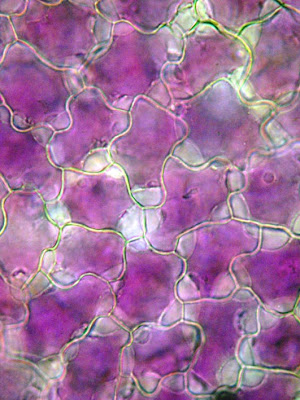This rather beautiful flower is Tibouchina urvilleana and the purple of its petals is due to the presence of anthocyanin pigments, which are dissolved in the cytoplasm of the petal cells.
If you magnify the petal surface about 200 times you can see the way in which the petal cells fit together, like pieces of a jigsaw puzzle. This piece of petal is mounted in water but if it's transferred to a concentrated solution of sugar ...
... the water in the cell begins to flow out through the semi-permeable cell membrane by the process of osmosis, with water travelling out from the less concentrated solution in the cell to the more concentrated solution surrounding it. Within a few minutes spaces become visible between the cytoplasm and the cell wall, where the cytoplasm shrinks ....
... and within a few more minutes the cytoplasmic contents of the cell have shrunk even further, so the purple anthocyanin pigment becomes even more concentrated in the remaining cytoplasm.
While I was looking at the petals I noticed something unusual around their edge - a fringe of microscopic hairs, invisible to the naked eye.
Each hair is tipped with a glandular head.

... that looks as through it may contain oils.
What are these hairs for? Secreting aromatic compounds that attract insect pollinators, perhaps?





















No comments:
Post a Comment
Note: Only a member of this blog may post a comment.